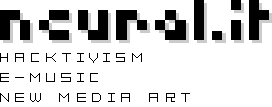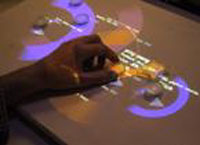





Italian version
Audiopad, interview with James Patten and Ben Recht.
interview done during Ars Electronica with James Patten and Ben Recht on their artwork Audiopad.
by Angela Serino.
How does your piece work from a technical point of view?
J.: The table has an antenna inside, and each of the objects on the top of the table have a coil of wire and a capacitor that resonates at a certain radiofrequency, kind of like a tuning fork resonate for sound. The antenna inside the table picks that up and actually there are a bunch of different antennas inside and they all measure this signal string. Using the string they can tell where the objects are on the table. The idea is that each of these objects represent a different part of a musical composition. For example: rhythm, melody, the bass line, the melody. There are two special objects on the table. One is the microphone, wherever the microphone is close to, is louder. So, that's how we control the volume. Then there is the other object that changes what the others do: so it when you change the samplers, you can change effects.
Did you record all the samplers?
B.: The samplers are things I recorded and collected from different competitions.
What is the idea behind this project?
B.: The idea with Audiopad is to have something where the gestures are more exaggerated then using a mouse. Even compared to a drum player we do something more, like moving arms and legs, stepping back and having a real interaction with the table, as much more like the kind of interaction you could see with real instrument, than the kind of interaction you have with the word processor.
I read about your previous exhibition with Audiopad, where you were playing on the floor. Can you tell me something more?
J: What we do mean by that -not to play on stage, but on a table on the floor- we try to be as much closer as possible to the audience. It's interesting for us to see the reaction of the public when we both play on the table, when we both want to play the same piece and you have the microphone going back and forward..
How did you choose the interface, I mean the little rounded pieces on the table?
B: The shape of the objects, that was the idea of James. They were just some objects that could have a nice shape, as an objects in itself. They are representative, but they don't really represent a meaning .The gestures are much more important. They are the key of this work.
J: We try to make a more expressive style of play. Because it's physical, there's also a dynamic that engages the audience. They can actually see what the performer is doing. The most important part of the idea of Audiopad is that people can see you moving your arms and listening to the change of the music you are playing: the process of interaction is visible and more clear.
Can your work be used from more than two people?
J: I suppose. I've been thinking about a more larger triangle table, with one person on each side and you can control sliding etc., but it is still an idea.
Your piece here looks like a kind of object that even people who don't know about music can play. It was also your own intention?
B: I think it is more like our installation works here. We tried to do it more simple, a little bit more transparent in this occasion. We took out some of the features we usually use to performance, because they are abstract, they look cool but they are hard to figure out. Here people can come in the museum and pretty quickly pick up what it is going on.
Do you think to continue to work together in the future?
J.: Yes, we think so. Ben is really interested in music, he plays a lot. I'm more interested in interaction, so I see us as a good combination. September, 2003.